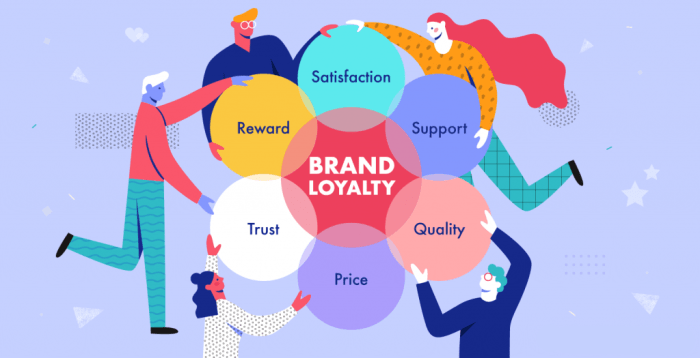Building a Brand Loyalty Program sets the stage for businesses to cultivate strong customer relationships and boost retention rates. Get ready to dive into the world of loyalty programs with a fresh perspective and dynamic strategies that will make your brand stand out.
In this guide, we’ll explore the importance of brand loyalty programs, the process of designing and implementing them, and how to measure their success effectively.
Importance of Brand Loyalty Programs

Brand loyalty programs are crucial for businesses as they help in retaining existing customers, attracting new ones, and ultimately driving revenue growth. By offering rewards, discounts, and exclusive deals, these programs incentivize customers to make repeat purchases and engage with the brand on a regular basis.
Examples of Successful Brand Loyalty Programs
- Starbucks Rewards: Starbucks’ loyalty program offers free drinks, food items, and personalized offers to its members. This program has significantly increased customer retention and engagement.
- Amazon Prime: Amazon’s subscription service provides members with free shipping, exclusive deals, and access to streaming services. It has led to higher customer loyalty and increased spending among members.
- Sephora Beauty Insider: Sephora’s loyalty program offers points for every dollar spent, which can be redeemed for beauty products and exclusive experiences. This program has helped Sephora build strong relationships with its customers.
Brand Loyalty Programs and Long-Term Customer Relationships
Brand loyalty programs play a vital role in fostering long-term relationships with customers. By continuously rewarding and engaging with customers, businesses can create a sense of belonging and loyalty among their customer base. This leads to increased customer satisfaction, repeat purchases, and positive word-of-mouth referrals, ultimately contributing to the overall success and growth of the business.
Designing a Brand Loyalty Program
Creating a successful brand loyalty program involves several key steps to ensure its effectiveness and appeal to customers. By understanding different types of loyalty programs and implementing best practices for rewards and incentives, businesses can build strong relationships with their customers and encourage repeat purchases.
Key Steps in Creating a Brand Loyalty Program
- Identify Target Audience: Understand the demographics, preferences, and behaviors of your target customers to tailor the loyalty program to their needs.
- Set Clear Objectives: Define the goals of the loyalty program, whether it’s increasing customer retention, acquiring new customers, or boosting sales.
- Choose the Right Program Type: Decide on the type of loyalty program that aligns with your brand and customer base, such as points-based, tiered, or subscription-based.
- Create Engaging Rewards: Develop rewards that are valuable and relevant to customers, such as discounts, exclusive offers, or free products/services.
- Promote the Program: Communicate the benefits of the loyalty program through various channels to attract and retain customers.
- Track and Analyze Performance: Monitor the effectiveness of the loyalty program through data analytics to make informed decisions and improvements.
Types of Brand Loyalty Programs
- Points-Based Programs: Customers earn points for purchases that can be redeemed for rewards, encouraging repeat buying.
- Tiered Programs: Customers progress through different levels based on their loyalty, unlocking exclusive perks and benefits at each tier.
- Subscription-Based Programs: Customers pay a recurring fee for access to premium features and rewards, fostering long-term engagement.
Structuring Rewards and Incentives
- Personalization: Tailor rewards based on customer preferences and behaviors to enhance their experience.
- Surprise and Delight: Offer unexpected rewards or perks to create memorable moments and strengthen customer loyalty.
- Gamification: Incorporate game-like elements, such as challenges or competitions, to increase customer engagement and participation.
- Experiential Rewards: Provide unique experiences, like VIP events or behind-the-scenes tours, to build emotional connections with customers.
Implementing a Brand Loyalty Program
Implementing a brand loyalty program can be a challenging task for companies, as it requires careful planning and execution to ensure its success. Companies may face several challenges when launching a brand loyalty program, such as lack of customer engagement, difficulty in tracking and measuring results, and competition from other loyalty programs in the market.
Challenges Faced When Implementing a Brand Loyalty Program:
- Low customer engagement: Convincing customers to participate in the loyalty program can be a hurdle, especially if they are already part of other programs.
- Tracking and measuring results: Companies may struggle to effectively track and measure the success of their loyalty program, making it difficult to make data-driven decisions.
- Competition from other programs: With so many loyalty programs available, standing out and offering unique benefits can be a challenge for companies.
Strategies for Launching a Brand Loyalty Program:
- Clearly define the program objectives and benefits for customers to create interest and engagement.
- Offer personalized rewards and incentives based on customer preferences and behavior to increase participation.
- Promote the program through multiple marketing channels, such as social media, email campaigns, and in-store promotions, to reach a wider audience.
Integrating a Brand Loyalty Program Across Marketing Channels:, Building a Brand Loyalty Program
- Ensure consistency in messaging and branding across all channels to create a unified customer experience.
- Utilize customer data and insights gathered from the loyalty program to tailor marketing campaigns and offers for better engagement.
- Collaborate with other departments, such as sales and customer service, to align the loyalty program with overall business goals and objectives.
Measuring the Success of a Brand Loyalty Program: Building A Brand Loyalty Program

To determine the effectiveness of a brand loyalty program, it is crucial to identify key performance indicators (KPIs) that can help evaluate its impact on customer retention and engagement. Analyzing customer data plays a significant role in measuring the success of a brand loyalty program as it provides insights into consumer behavior, preferences, and overall satisfaction. Utilizing tools and techniques to track and assess the performance of the loyalty program is essential for making data-driven decisions and optimizing strategies for long-term success.
Identifying Key Performance Indicators (KPIs)
- Customer Retention Rate: Measure the percentage of customers who continue to engage with the brand over a specific period.
- Repeat Purchase Rate: Evaluate how often customers make repeat purchases and their loyalty to the brand.
- Net Promoter Score (NPS): Determine the likelihood of customers recommending the brand to others, reflecting satisfaction and loyalty.
Analyzing Customer Data for Measurement
- Segmentation Analysis: Divide customers into groups based on behavior, demographics, or purchase history to identify trends and preferences.
- RFM Analysis: Evaluate recency, frequency, and monetary value of customer transactions to understand their loyalty and engagement levels.
- Sentiment Analysis: Monitor customer feedback, reviews, and social media interactions to gauge satisfaction and loyalty towards the brand.
Tools and Techniques for Tracking Performance
- Customer Relationship Management (CRM) Software: Utilize CRM platforms to store customer data, track interactions, and measure engagement metrics.
- Loyalty Program Analytics: Implement analytics tools within the loyalty program to monitor member activity, redemption rates, and overall program performance.
- Surveys and Feedback Forms: Collect feedback from customers to assess their satisfaction levels, loyalty, and suggestions for program improvement.





